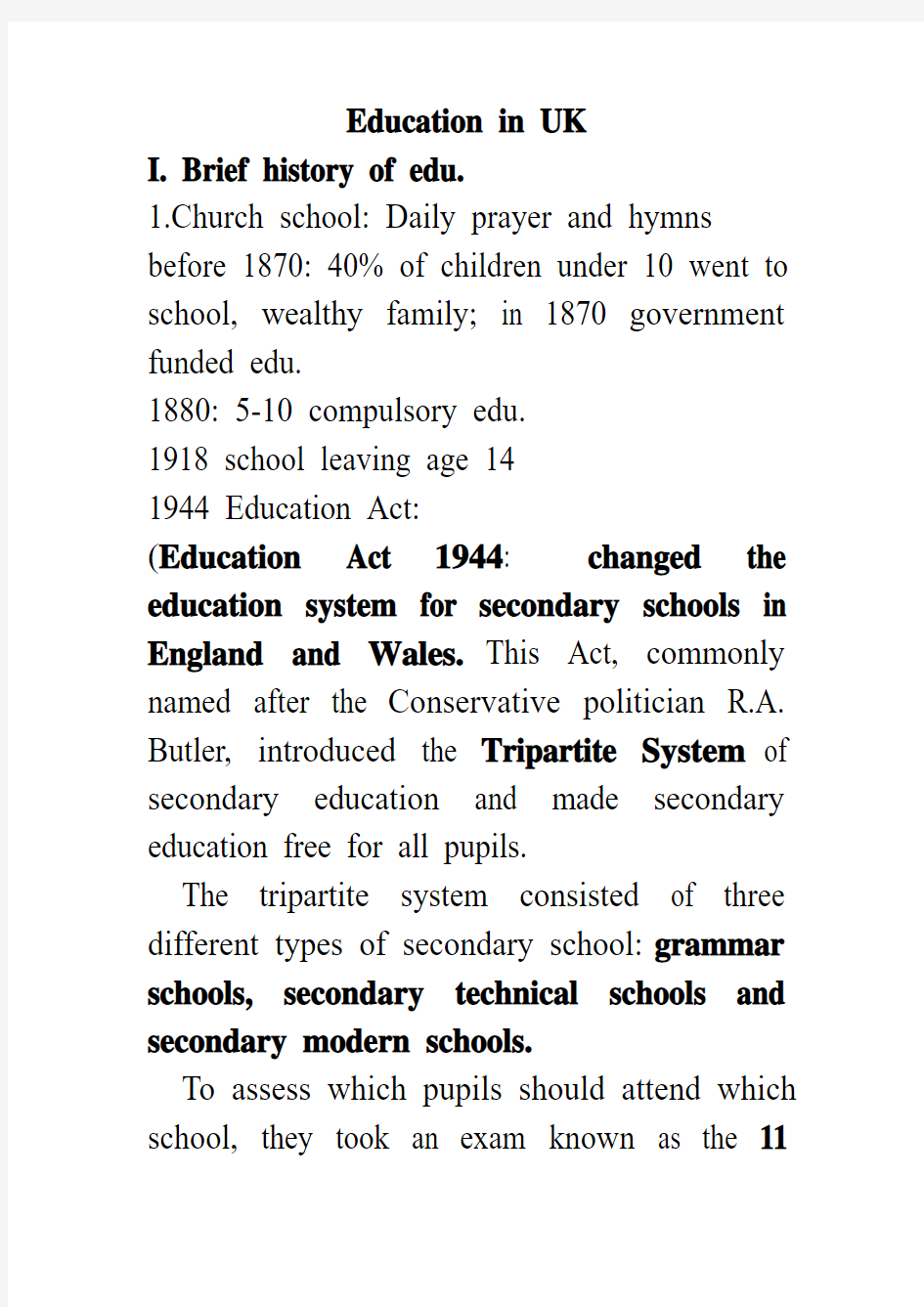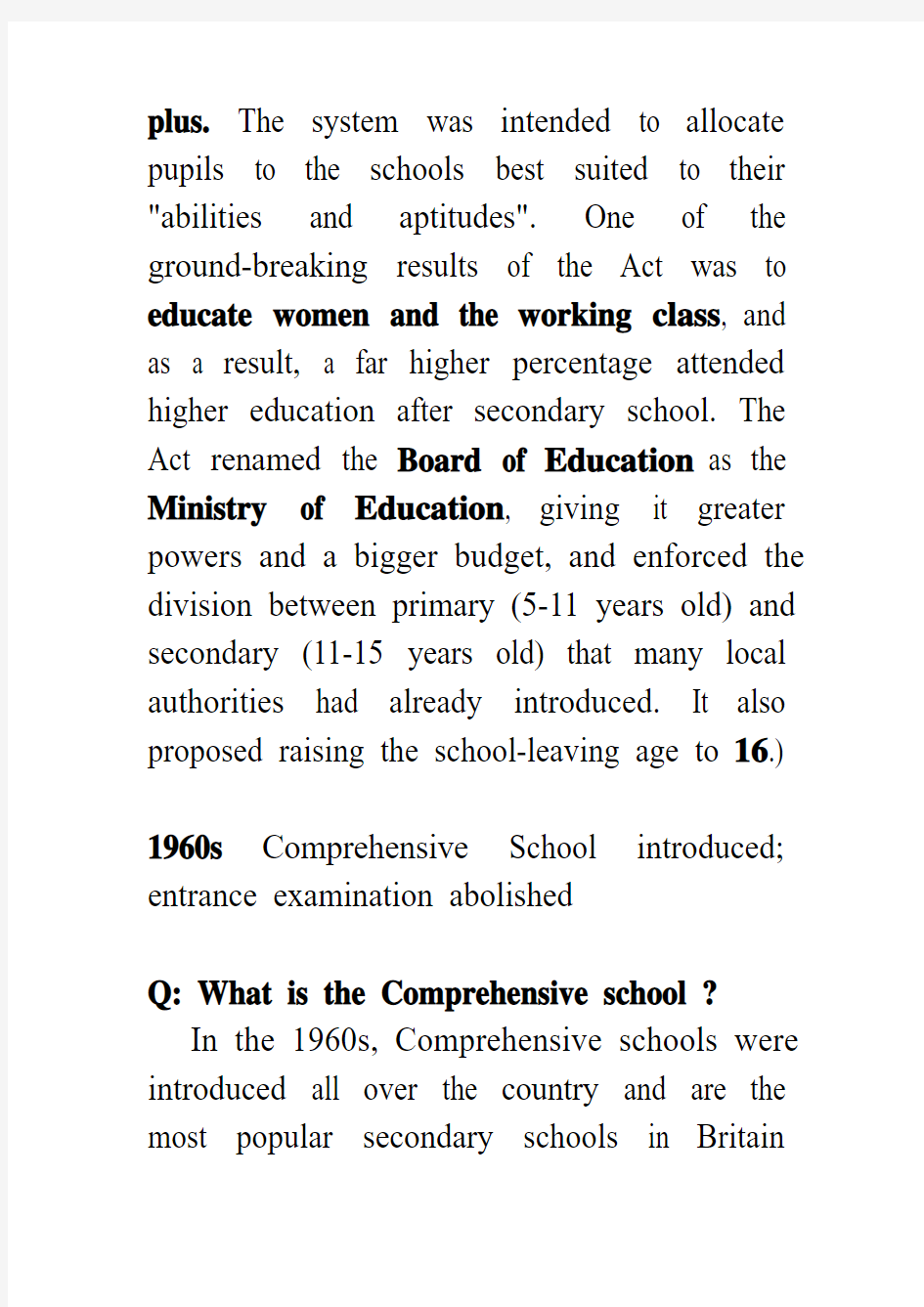unit 7 british education


Education in UK
I. Brief history of edu.
1.Church school: Daily prayer and hymns before 1870: 40% of children under 10 went to school, wealthy family; in 1870 government funded edu.
1880: 5-10 compulsory edu.
1918 school leaving age 14
1944 Education Act:
(Education Act 1944: changed the education system for secondary schools in England and Wales.This Act, commonly named after the Conservative politician R.A. Butler, introduced the Tripartite System of secondary education and made secondary education free for all pupils.
The tripartite system consisted of three different types of secondary school: grammar schools, secondary technical schools and secondary modern schools.
To assess which pupils should attend which school, they took an exam known as the 11
plus. The system was intended to allocate pupils to the schools best suited to their "abilities and aptitudes". One of the ground-breaking results of the Act was to educate women and the working class, and as a result, a far higher percentage attended higher education after secondary school. The Act renamed the Board of Education as the Ministry of Education, giving it greater powers and a bigger budget, and enforced the division between primary (5-11 years old) and secondary (11-15 years old) that many local authorities had already introduced. It also proposed raising the school-leaving age to 16.)
1960s Comprehensive School introduced; entrance examination abolished
Q: What is the Comprehensive school ?
In the 1960s, Comprehensive schools were introduced all over the country and are the most popular secondary schools in Britain
today. Such schools admit children without reference to their academic abilities and provide a general education. Pupils can study everything from academic subjects like literature to more practical subjects like cooking.
Q: What is the Grammar school? Grammar schools select children at the age of 11, through an exam called ―the 11-plus‖. Those children with the highest marks go to grammar schools. These schools lay emphasis on advanced academic subjects rather than the more general curriculum of the comprehensive schools and expect many of their pupils to go on to universities.
What is the Public school?
In the private sector there are independent schools which are common, but confusingly, called public schools. (They are called public schools because they were originally seen as
―public‖ alternatives to having private tutors in aristocratic households.) They receive their funding through the private sector and through tuition rates, with some government assistance. They are not part of the nation education system, but the quality of instruction and standards are maintained through visits from Her Majesty’s Inspectors of Schools. Parents choose to pay fees in order to send their children have a better chance of getting into good universities and getting better jobs when they leave school.
Q: What is the difference between Grammar Schools and Comprehensive schools?
Grammar schools are selective, they offer academically oriented general education. Entrance is based on a test of ability, usually at 11, called the Eleven Plus (11+).Comprehensive schools, on the other hand, are non-selective, they do not select pupils on grounds of ability.
1989 National curriculum: English, mathematic, science, religious edu. History, geography, technology, music, art, PE, modern foreign language
II. The present Education System
1. Primary and secondary education in the UK is compulsory. Children between 5 --16 years old are obliged to attend school.
2. Children between 5 ---11 go to primary school (state schools; co-educational or mixed schools).
3. Children between 11 ---19 go to secondary schools (90% of them are enrolled to comprehensive schools without reference to their academic abilities).
TYPE OF SCHOOL AVERAGE FEES PER TERM
Nursery (0-5) £1,607 Junior/prep (5-11)
Day pupils at day schools
£2,640 Day pupils at boarding schools
£3,231
Boarders £4,343
Senior (11-16)
Day pupils at day
£2,963 schools
Day pupils at
£4,038 boarding schools
Boarders £6,678
Sixth Form (16-18)
Day pupils at day
£3,002 schools
Day pupils at
£4,443 boarding schools
Boarders £7,177
The private schools = independent schools = public schools ( because they were originally seen as public alternative to having private tutors in aristocratic households)---- funded by private sectors, through tuition rates and some government assistance. Independent schools are not part of the national education system. The quality of instruction and standard are
obtained through visits from Her Majesty’s Inspector of Schools.
IV. Examinations after the secondary education
a. GCSE Examinations (General Certificate of Secondary Education) ----after 5 years of secondary education , English , Northern Irish and Welsh students sit the exams which is to assess their progress in their final 2 years of compulsory education. Then, they will decide what avenue of education they would like to follow based on the results of the examinations.They have a number of choices ----- quit school to find a jo
b.
GCE: A-Level
◆ prepare for university entrance examination
2 –year-further study after the GCSE ( in the 6th form) then sit for the GCE- Advanced)
examination.
b. GNVQ----( General National Vocational Qualifications ) To sit the GNVQ for vocational training or preparation for work. 注:GCSE exams(General Certificate of Secondary Education)
V. Higher Education
◆ British higher education has a long history in the UK--- Oxford and Cambridge date back to the 12th and 13th century; Scottish universities of St. Andrew, Glasgow, Edinburgh and Aberdeen date back to the 14th and 15th century; the rest were built in the 19th and 20th centuries. In the 1960s a large number of universities were built. In 1992, the number grew when polytechnics and other higher education establishments were given the right to become universities.
Q: How many institutions of higher learning in UK?
NUMBER OF INSTITUTIONS (AS AT AUGUST 2007)
Q: What is the Open University?
Open University-- and open education------ in England it takes3 years’ full time study to get the first degree for an open university learner; 4 years in Scotland. It was founded in Britain in the 1960s for people who may not
get the opportunity for higher education for economic and social reasons. It’s open to everybody and doesn’t demand the same formal educational qualifications as the other universities. University courses are followed through TV, radio, correspondence, videos and a network of study centers. At the end of their studies at the Open University, successful students are awarded a university degree.
Types of degree
Undergraduate
BSc (Bachelor of Science)
BA (Bachelor of Arts)
BEng (Bachelor of Engineering) Postgraduate
MSc (Master of Science)
MA (Master of Arts)
MEd (Master of Education)
LLM (Master of Law)
MBA (Master of Business Administration) PhD
If you would like to continue to study for a PhD, you will have to conduct a minimum of two years' research after the award of your MSc. In some subject areas, a student may transfer from BSc/BA/BEng to PhD so that they follow a three year research programme for PhD without first obtaining a Masters degree.
What is GPA? How to Calculate GPA?
Your grade point average (GPA) is calculated by dividing the total amount of grade points earned by the total amount of credit hours attempted. Your grade point average may range from 0.0 to a 4.0.
For example:
A=4 grade points
B=3 grade points
C=2 grade points
D=1 grade point
WF/F=0 grade points
P/NP (Pass/No Pass) courses are not factored in the student's GPA
I (Incompletes) and W (Withdrawals) do not receive grade
points and do not have an effect on the GPA
To get the example student's GPA, the total grade points are divided by the total credit hours attempted.
So the GPA is 2.10.
